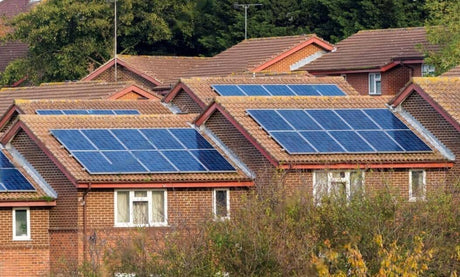Adding a PV system to your home is one the best and most economical decisions you can make. You can get away from the local power grid, spend less on energy, and arm your home with battery backups in case the grid fails or the power goes out.
Unfortunately, installing a PV system is not as simple as collecting an array of solar panels and attaching them to your roof or your front lawn. You need to know how to size your PV system so you can get the maximum voltage out of it without exceeding limitations. This way, you can accommodate as much of your home's needs as possible without relying on the local power grid.
Photovoltaic systems are a relatively new technology that wasn't always a viable option. However, as technology races forward and designs become more sophisticated, PV systems become more and more affordable. Today, the savings are absolutely worth the effort of understanding and assembling PV systems. After reading this article, you will better understand PV system fundamentals and how to approach designing your own PV system at home.
What Is Array Voltage?
PV array voltage is the sum total voltage of your panels when connected in a series. Two 24V panels connected in series will make a PV array voltage of 48V. However, keep in mind that if these same two panels were connected in parallel, the PV array voltage would still be 24V.
Knowing your array voltage allows you to do two things, with consideration to your inverter's maximum input voltage. You can increase the size of our system design to produce more power, and you can limit your system design so as not to put your inverter or electrical system at risk. If you assemble your array correctly, you can produce enough power to get off-grid for an extended period of time.
What Is PV Voltage?
PV voltage is the voltage produced by an individual PV cell. Each individual photovoltaic cell produces what's called open circuit voltage, or VOC. A PV cell typically produces around 0.5 or 0.6 volts at standard testing conditions, regardless of their actual size.
Voltage at open circuit can be read with a voltmeter or multimeter, specifically when the module isn't connected to a load. Typically, you can find this figure on the PV module's data sheet. This number will be important for later when calculating the size of your system for your home's needs.
PV voltage is different from solar thermal energy. PV voltage uses the photovoltaic effect to generate power. This is when photons impact a surface made of semiconducting material, enabling the release of an electron. However, solar thermal panels rely on sunlight energy to heat a fluid (typically water, oil, air, etc.). While both systems can convert energy to AC for use, PV systems are more sophisticated and more common in the home.
Using a charge controller and deep cycle batteries, you can store power for use later or even create a backup system for essential appliances.
How Do You Calculate PV voltage?
Knowing the maximum number of modules you can include is very important when determining the right system design for your PV system. This is because the voltage has an inverse relationship with ambient temperature. The colder it gets, the higher the voltage produced by your string. If you've mistakenly placed too many modules on the same string, it's possible to exceed the maximum voltage input of the inverter. This can lead to damage to your electrical equipment and a potential fire outbreak.
To calculate this, you need to find the Module Voc_max, which is the maximum module voltage corrected for the install site's lowest expected ambient temperature. To find that, you need to resolve the following formula:
Module Voc_max = Voc x [1 + (Tmin - T_STC) x (Tk_Voc/100)]
Voc is the module's rated open current voltage, which you can find on its datasheet. Tmin is the lowest expected ambient temperature of the install site. T_STC is the temperature at standard test conditions or 25°C. Finally, Tk_Voc is the module's open current voltage temperature coefficient, usually found as a %/°C on the module datasheet. Keep in mind that Tk_Voc is always expressed as a negative number.
Now, to find your maximum string size, all you need is the maximum voltage input for your inverter, typically found on the inverter's datasheet. Divide this number by your Module Voc_max, and you will have your maximum string size.
How Do You Calculate Solar Array Voltage?
Calculating solar array voltage will depend on how your panels are connected. There are two ways to do this. You can connect your panels in series or parallel. If your panels are connected in series, calculating array voltage is as simple as adding the voltage of each panel together to find the total. For a solar array connected in series, the total voltage will be your array voltage.
For an array connected in parallel, the calculation is a little different. While the amperage of the array will be the sum of amps of all panels, the voltage will always be the voltage of a single panel.
Finding your solar array voltage is very important, specifically because you need to avoid exceeding your inverter's maximum input voltage. The inverter is arguably the most important part of solar energy power systems. The inverter converts the energy produced by your photovoltaic array into AC (alternating current), so you can actually use that energy. Exceeding the limit of the inverter can lead to damage and potential fire hazards.
How to Properly Size a PV Solar System
The first step in sizing your PV solar system is understanding your average monthly power usage. The easiest way to measure this is by collecting your energy bills from the last year, adding up the kWhs, and dividing by 12. The result will be your average kWh usage per month. You can divide this number by 30 to get your approximate daily kWh usage.
Insolation
Next, using a solar insolation table, determine insolation for your area. Insolation is the average number of hours per day the sun produces peak sunlight in your area. Alternatively, it's the sum of all sunlight equal to that amount of peak sunlight. The best way to do this is to find the insolation for the city nearest to you and write down that figure.
Now we have two important figures: your daily kWh and the number of hours of peak sunlight in your area. Divide your daily kWh by the number of peak hours. Take the result (#kW) and multiply it by 1.3. This is the increase in the size of PV systems by 30%. The result will be the actual size PV system for your home, measured in kW.
Quantity
From here, you'll need to determine how many solar panels you'll need to achieve the size you need. To do this, you will need your daily kWh and insolation again. Divide your daily kWh by the number of peak hours. Then divide the result by the efficiency of the solar panel you're interested in. This will tell you how many panels you'll need.
Finally, it all comes down to how much space you have and the budget you're working with. Depending on the system you select, you may need a roof-mounted system or a ground-mounted system.
Monocrystalline and Polycrystalline Options
When choosing solar panels, you have options. You can select from monocrystalline and polycrystalline panels, as well as 12, 24, and 48 volt systems. Monocrystalline is more compact and energy-efficient but more expensive. Polycrystalline has lower energy efficiency and is larger of the two types, but it is less expensive. As for voltage, the best choice will be based on your home's energy needs and how much space is available to accommodate a PV system that can take you fully off-grid.
Discover the Power of Photovoltaic Systems
Now that you have a deeper understanding of PV systems and how to measure array voltage and PV voltage, it's time to start looking into systems for your home. You can use your knowledge to equip your home with solar panel kits, inverters, and charge controllers to harness renewable energy with limited environmental impact.
With a little knowledge, you can reduce your energy bill, your reliance on the grid and even create an emergency backup system to keep your home functioning during a blackout. If you're not 100% confident in doing this yourself, a licensed electrician can install a PV system to spec and may even install the systems you choose or provide.
If you need help deciding on which components are best for your needs, you can always check out our learning center for all the information you could need, including product documents, videos, and more.










